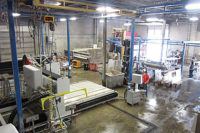The stone selection process started in the same fashion as many projects — to find a material that would create a welcoming aesthetic. “Of the goals set from the visioning, the goal to creating warm, inviting spaces is the one that most heavily influenced the final aesthetic throughout the campus,” explained Lynda Cobbs Brookshire, ASID of tvsdesign in Atlanta, GA.
The design utilizes slabs of African Fantasy granite — supplied by G & L Marble of Winston, GA — for the feature wall and reception desk. The material was received in Nashville, TN, by Seven Hills Granite, which coordinated the final fabrication and installation provided by Design Stone, also of Nashville.
“In selecting stone slabs, we worked very closely with the Construction Manager (CM) throughout the process,” said Brookshire. “We provided our sample piece of the African Fantasy for the CM to give G & L as a reference in locating slabs with the most similar look. We reviewed photographs of various slabs, and when we found a series with the right look, they were purchased and shipped to G & L’s warehouse in Atlanta, where we reviewed them to ensure they were consistent with the images and were quality material. From there, they were shipped to Seven Hills Granite in Nashville, where they took responsibility for coordinating the final part of the process with Design Stone.”
In total, eight slabs were shipped from Africa. “We reviewed the slabs in detail, and with masking tape, we identified how each slab would be cut and fit together so we could best achieve the appearance that the stone installed on the feature wall came from one slab instead of many different ones,” explained the interior designer. “We took the same approach in selecting the slabs for the reception desk. Identifying how the slabs could be cut at the needed sizes while maintaining a consistent match of the grain’s patterning at both the ends and sides was critical to achieving the look we wanted.”
The collaborative process continued at the jobsite itself. “After the stone was cut and fabricated, we went to the site to review it in place as a mock-up before it was fully installed,” Brookshire said. “The alignment with portions the adjacent architecture was off, so it was all dismantled and taken back to Nashville for proper adjustments. They came back a second time to install the stone, and it worked out perfectly.”
At first glace, this may seem like a lot of effort for an eight-slab project, but the end result was an outstanding display of architectural slabwork — one that may well gain additional business for the suppliers, fabricators and installers in the future.
In my opinion, the cooperation among the various parties for the BlueCross BlueShield is an example that can be carried over to projects of all sizes — from large-scale commercial projects to simple kitchen renovations. At a time when stone suppliers are going after a market of customers that is far smaller than it was a few years ago, these efforts to communicate with the client — whether it is an architect, interior designer or homeowner — can make the difference between success and failure. More importantly, in an industry where word of mouth and referrals are often a key component for finding new clients, going the extra mile is becoming the new standard for successful businesses.



